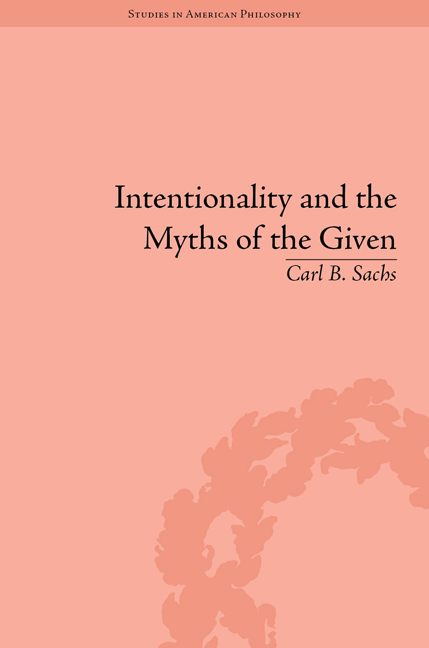Book contents
- Frontmatter
- Contents
- Acknowledgements
- Introduction: Why a New Account of Intentionality?
- 1 Intentionality and the Problem of Transcendental Friction
- 2 The Epistemic Given and the Semantic Given in C. I. Lewis
- 3 Discursive Intentionality and ‘Nonconceptual Content’ in Sellars
- 4 The Retreat from Nonconceptualism: Discourse and Experience in Brandom and McDowell
- 5 Somatic Intentionality and Habitual Normativity in Merleau-Ponty's Account of Lived Embodiment
- 6 The Possibilities and Problems of Bifurcated Intentionality
- Conclusion
- Appendix: Is Phenomenology Committed to the Myth of the Given?
- Works Cited
- Notes
- Index
4 - The Retreat from Nonconceptualism: Discourse and Experience in Brandom and McDowell
- Frontmatter
- Contents
- Acknowledgements
- Introduction: Why a New Account of Intentionality?
- 1 Intentionality and the Problem of Transcendental Friction
- 2 The Epistemic Given and the Semantic Given in C. I. Lewis
- 3 Discursive Intentionality and ‘Nonconceptual Content’ in Sellars
- 4 The Retreat from Nonconceptualism: Discourse and Experience in Brandom and McDowell
- 5 Somatic Intentionality and Habitual Normativity in Merleau-Ponty's Account of Lived Embodiment
- 6 The Possibilities and Problems of Bifurcated Intentionality
- Conclusion
- Appendix: Is Phenomenology Committed to the Myth of the Given?
- Works Cited
- Notes
- Index
Summary
Subsequent to the publication of Rorty's Philosophy and the Mirror of Nature in 1979, innovative philosophical appropriations of Sellars went into relative eclipse. This eclipse ended in 1994, when Robert Brandom and John McDowell published their respective magnum opera, Making It Explicit: Reasoning, Representing, and Discursive Commitment and Mind and World. Subsequently both Brandom and McDowell have done much to revive a serious interest in Sellars's contributions to epistemology and philosophy of mind (though Sellars's contribution to metaphysics and metaethics have yet to undergo a comparable renaissance). The recognizably Sellarsian strand in their works consists of their commitment to avoiding the Myth of the Given in both the epistemic and semantic versions, to affirming the irreducibility of the normative (‘the space of reasons’) to the natural within a ‘relaxed’ or ‘liberal’ naturalism, and to following Sellars's own lead in moving beyond a Kantian analytic philosophy to a Hegelian one. Yet neither Brandom nor McDowell are Sellarsians in the sense of being mere epigones, nor should their substantial areas of agreement distract us from sober appraisal of their considerable disagreement.
Instead of proposing a comprehensive discussion of each of these fascinating philosophers – let alone a comprehensive comparison – I will keep the subsequent analysis focused on the following questions: (1) does the very idea of experience, as distinct from judgment, require nonconceptual content (in the stipulative sense outlined in Chapter 1)? and (2) does the rejection of the Myth entail the rejection of nonconceptual content?
- Type
- Chapter
- Information
- Intentionality and Myths of the GivenBetween Pragmatism and Phenomenology, pp. 71 - 100Publisher: Pickering & ChattoFirst published in: 2014



